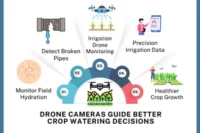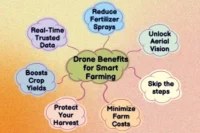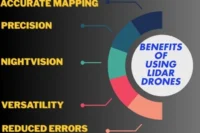How Drones Are Changing the Way Farmers Grow Crops
Published: 6 Aug 2025
Over 30% of Indian farmers using drone technology say it’s helped them reduce pesticide use by nearly half. That’s a big deal. Wondering how drones are used in agriculture? It’s not just about flying cameras. Drones help scan fields, identify pest problems, and spray with precision. Instead of guessing where to treat crops, farmers now rely on aerial data. This means healthier crops, fewer chemicals, and better yields. The numbers don’t lie, drones are changing how farming works, and fast. In this article, we’ll explore how drones are used in agriculture to boost crop yields.
Lower Pesticide Use With Drones
Many farmers spray their whole fields with pesticides, even when only a few parts are affected. This wastes chemicals and money. Drones help fix that by spraying only where it’s needed.
Wasted Sprays : Traditional methods spray everything—healthy or not. This means a lot of pesticide goes where it’s not needed, which increases cost and harms the soil.
Spot-Specific Treatment : Drones scan the field first. Then they spray only the spots with pest problems. This way, no chemical is wasted, and the crops stay healthier.
Fewer Chemicals Used : With drones, farmers use less pesticide because they’re not spraying blindly. That means safer food, cleaner soil, and lower expenses.
Proven Results : A small farm in India switched to drone spraying and cut chemical costs by 40%. They also saw fewer sick plants and better overall crop health.
Scanning Fields From the Sky
When farmers walk through fields, it’s easy to miss signs of trouble—especially on large farms. Drones give a clear view from above, making it easier to spot issues early and take action.
Ground Limits : From the ground, it’s hard to see patterns like dry spots or pest damage. Drones solve this by giving a full top-down view of the entire field.
Aerial Images : ones can scan large fields in just a few minutes. This saves hours of walking and helps spot problems quickly.
Useful Insights : The images show areas with poor plant growth, water stress, or pest attacks. This helps farmers act early and avoid major losses.
Spotting Problem Areas Quickly
Crops don’t show every problem clearly from the ground. But drones help farmers see early signs of trouble—so they can act fast and protect their yield.
Hidden Trouble : Drones look for signs like dry patches, yellowing leaves, pest damage, or disease. These are often hard to spot without an aerial view.
Early Warnings : By catching these issues early, farmers can treat them before they spread. This saves time, money, and prevents crop loss.
Faster Action : With drone images, farmers don’t need to guess where problems are. They know exactly where to go and what to fix.
Real Example : One farmer used a drone to spot a fungal infection on one side of his field. He treated it that same day—and saved most of his harvest.
Spraying With High Precision
Spraying chemicals by hand or tractor can be messy and uneven. A drone for farm use makes it easier by spraying exactly where it’s needed—with no guesswork and no waste.
Smart Equipment : Drones come with a built-in tank and a spray system. They carry the liquid and spray it while flying over the crops.
Close and Accurate : The drone flies low and sprays only the target areas. This helps cover just the right spots without touching healthy plants.
No Human Mistakes : Unlike manual spraying, drones follow a pre-set path. This means fewer errors and a more even spray.
Cleaner and Safer : Precision spraying reduces chemical waste. It also keeps the soil, air, and nearby plants safer from harm.
Data-Based Crop Treatment
Farming is no longer just about skill. Drones give real data that helps farmers make smarter choices about how to care for their crops.
Useful Farm Data : Drones collect information like plant growth, soil moisture, and overall crop health. This helps farmers understand what’s really happening in their fields.
Right Time, Right Spot : With this data, farmers know exactly where to treat, what to use, and when to act. It avoids over-treating or missing key areas.
Better Planning : Instead of reacting late, farmers can plan ahead using drone insights. This means fewer surprises and more control.
No More Speculation : Decisions are based on facts, not assumption. That leads to healthier crops, less waste, and better use of time and resources.
Better Yields With Drone Help
When farmers use drones, they spot problems early, treat crops better, and make quicker decisions. All of this leads to stronger plants and more harvest at the end.
Fewer Crop Losses : Drones help catch issues before they grow. That means fewer damaged crops and more that survive till harvest.
Faster Fixes : With clear drone images, farmers can act fast—no delays, no confusion. Quick action keeps crops healthy and strong.
Healthier Plants : Precise spraying and data-based care lead to stronger, greener plants. Healthy crops grow better and resist disease more easily.
More Output, More Profit : The final result? More crops to sell and better quality harvests. That means higher profits with less waste.
Final Thoughts
Drones are not just flying machines, they are smart tools that help farmers work faster, waste less, and grow more. From scanning fields and spotting problems early to spraying with precision and using real data for crop care, drones are changing how farming works.
Small farmers don’t need to buy expensive equipment to get started. Many drone service providers offer low-cost spraying and field-mapping services. Plus, some government schemes and agri-tech startups support drone use with training and subsidies.





